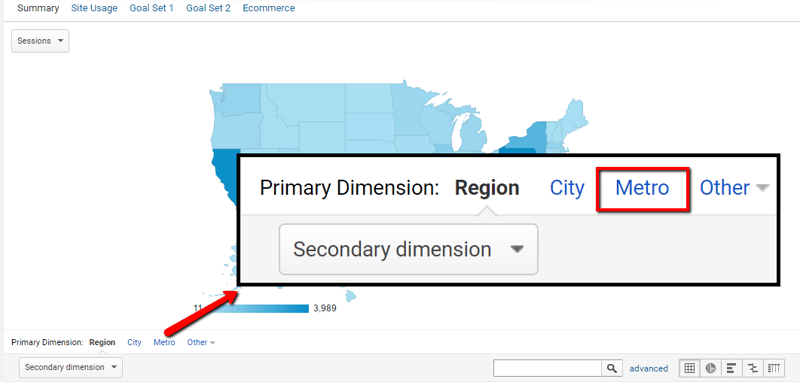Secondary Dimension in Google Analytics: Unlocking Advanced Metrics
Secondary Dimension in Google Analytics: Unlocking Advanced Metrics
Blog Article
Gain Comprehensive Point Of Views With Additional Dimension in Google Analytics
Second dimensions in Google Analytics serve as a powerful device for enhancing the deepness of insights originated from information evaluation. By including secondary dimensions into your reports, you open up a globe of opportunities for revealing intricate partnerships and nuanced patterns within your web site's performance metrics. This extra layer of info can illuminate surprise patterns and provide an extra granular understanding of individual actions. With the capacity to segment and compare data across multiple dimensions, the possibility for obtaining actionable insights is vast. Remain tuned to find exactly how additional dimensions can reinvent your information evaluation and drive educated decision-making in the electronic world.
Understanding Secondary Measurements in GA
Additional measurements enable individuals to dive deeper right into their data by including an additional layer of information to the key data being analyzed. By incorporating secondary measurements, users can segment and contrast information throughout various dimensions, such as website traffic resources, user tools, geographic locations, and much more.
Understanding exactly how to properly use second dimensions in Google Analytics is crucial for extracting beneficial insights from the data gathered. By choosing the proper secondary dimensions to complement key metrics, individuals can uncover patterns, trends, and connections that may have or else gone unnoticed. This much deeper level of analysis can bring about even more informed decision-making and the optimization of electronic advertising and marketing methods to enhance overall performance.
Benefits of Utilizing Secondary Measurements
Checking out the benefits integral in leveraging secondary measurements within Google Analytics brightens the deepness of understandings available for enhancing information analysis. By incorporating additional dimensions, customers can acquire an extra extensive understanding of their main data metrics.
Additionally, secondary dimensions allow users to compare and contrast different data points within the very same record, supplying a more holistic view of site performance. This comparative analysis can clarify the efficiency of advertising and marketing projects, web content involvement, or customer demographics. Furthermore, using second measurements can aid in determining outliers or anomalies that may call for more investigation.
Fundamentally, leveraging second dimensions in Google Analytics uses a powerful device for extracting important understandings and maximizing data-driven decision-making processes.
Carrying Out Secondary Dimensions Properly
To successfully implement second dimensions in Google Analytics, planning the choice and application of these added data layers is extremely important for maximizing the deepness of understandings stemmed from analytics reports. When selecting secondary dimensions, consider the particular objectives of your evaluation to ensure the chosen measurements align with the information needed to address relevant concerns. It's vital to focus on relevance over amount, choosing dimensions that enhance the main measurement and provide meaningful context.
Applying secondary dimensions efficiently involves using them to discover patterns, trends, and correlations that may not be evident when analyzing data solely based on the primary measurement. By including additional measurements attentively, you can enhance the granularity of your analysis and gain much deeper insights right into customer behavior, content performance, and other key metrics within Google Analytics.
Studying Information With Second Dimensions
Making use of secondary measurements in data evaluation provides a nuanced perspective that discovers complex partnerships and patterns within Google Analytics records. By integrating secondary dimensions together with key measurements, experts can dive deeper right into the data to extract valuable insights. This method makes it possible for the recognition of connections that might not be right away obvious when examining information entirely based upon key dimensions.
When examining information with additional dimensions in Google Analytics, it is necessary to consider the certain metrics or pop over to these guys measurements that will certainly provide one of the most meaningful context for the key dimension being assessed. For instance, pairing the key measurement of 'traffic resource' with secondary measurements such as 'tool group' or 'landing page' can use an extra detailed understanding of individual actions and preferences.
Furthermore, the capacity to section information making use of secondary dimensions permits a more granular assessment of individual interactions, assisting in the optimization of advertising and marketing approaches, web site performance, and overall individual experience. By leveraging additional measurements properly, businesses can make educated choices based on a thorough evaluation of their Google Analytics information.
Finest Practices for Additional Dimensions
When executing secondary measurements in Google Analytics, precision in picking relevant metrics is extremely important for obtaining actionable insights from the data analysis process. Among the finest practices for using additional measurements successfully is to straighten them with your key measurement to obtain a much more detailed understanding of your internet site or project efficiency. For instance, if your key dimension is 'Source/Medium,' combining it with secondary dimensions like 'Device Classification' or 'Touchdown Page' can give understandings right into just how various tools or landing pages effect web traffic from various resources.

Regularly exploring with various mixes of main and second dimensions can help you find brand-new connections and fads within your data, enabling you to maximize your techniques and improve total efficiency (Secondary Dimension in Google Analytics). By following these ideal practices, you can leverage additional dimensions in Google Analytics efficiently to obtain deeper understandings and make data-driven decisions that positively affect your company

Conclusion
In final thought, additional measurements the original source in Google Analytics offer a useful opportunity to acquire deeper insights into main information metrics. By adding a second measurement to records, organizations can uncover connections, patterns, and patterns that may not be instantly apparent, bring about a much more extensive understanding of user behavior and communications on a web site. Carrying out second dimensions effectively and evaluating data with them can aid businesses make data-driven decisions and maximize their on the internet efficiency.
By incorporating additional measurements, individuals can sector and compare data throughout different measurements, such as web traffic sources, customer tools, geographical areas, and extra. Executing second measurements successfully involves utilizing them to discover patterns, patterns, and connections that may not be obvious when examining data only based on the key dimension. By more information integrating secondary measurements alongside key dimensions, analysts can delve deeper into the data to remove useful insights. One of the finest methods for using secondary measurements successfully is to align them with your primary dimension to get an extra comprehensive understanding of your web site or campaign efficiency. If your key dimension is 'Source/Medium,' matching it with second measurements like 'Gadget Classification' or 'Landing Web page' can supply insights right into exactly how different devices or touchdown pages impact website traffic from numerous sources.
Report this page